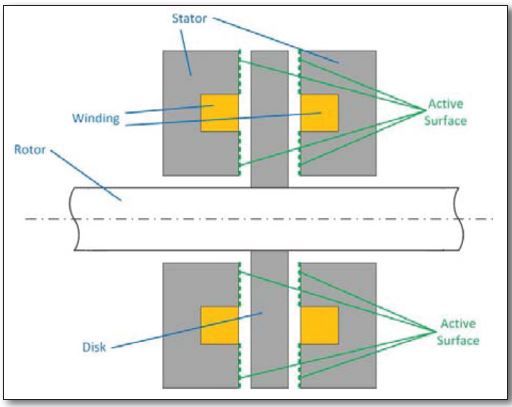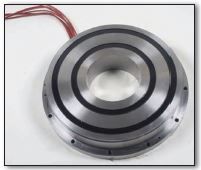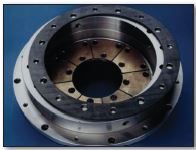Axial Loads and Active Magnetic Bearings
STRATEGIES TO OPTIMIZE THE DESIGN AND LOAD CAPACITY OF ACTIVE MAGNETIC BEARINGS UNDER AXIAL LOADS
Since their introduction more than 30 years ago, active magnetic bearings (AMBs) have become standard for turboexpanders and high-speed compressors. As the use of AMBs expands, OEMs and AMB vendors must address the inherent differences between hydrodynamic and magnetic bearing capabilities.
One area to address is thrust load capacity. AMBs have lower load capacity than conventional hydrodynamic bearings (Turbomachinery International, July/August 2015). Several techniques exist, however, to optimize the design of axial AMBs and mitigate the effects of high axial load. AMBs are also capable of controlling machine dynamics and reducing axial loads generated within a machine.
Static loads
When using AMBs, a distinction must be made between static (zero or low frequency) and dynamic (high frequency) load capacity. Similarly, there is a distinction between low frequency and high frequency stiffness and damping. The static load capacity of the actuator in a magnetic bearing is defined by the surface area of the stator pole faces (Figure 1) together with the maximum achievable flux density (also known as the saturation flux density) for the material in the disk and stator parts. To increase the static load capacity, either the area or the flux density must be increased.

Figure 1: Schematic of an axial AMB showing the active working area of the stator[/caption]
The materials typically used for high-flux-density machines are not available in bulk solid form; consequently, manufacturing thrust disks from these materials is challenging. It is more straightforward to increase the surface area of the stator pole faces.
Surface area can be increased using one of several methods. The first is to increase the outer diameter (OD) of the thrust disk. While a simple solution, there are trade-offs. The diameter of the disk will be limited by its burst speed, which is primarily a function of its operating speed and yield strength. This means that compromises must be made between the mechanical properties of the disk material and the magnetic properties. In addition, a large diameter disk (typically located at the shaft end) is not desirable from a rotordynamic perspective. It will drop the natural frequency of the lateral modes, thus reducing the separation margins for higher order modes. Large diameter disks may also introduce lateral modes dominated by the disk mode; these modes can be analyzed only with full Finite Element Analysis techniques. Finally, the larger thrust disk increases the windage losses between the thrust collar and axial actuator. While this may not limit the achievable diameter, it will impact overall design.
Surface area can also be increased by reducing the winding volume. The winding slot geometry is constrained by the achievable current density in the winding, which is governed by the ambient temperature of the machine, the rating of the insulation material and the cooling paths to the exterior. Maximum use of the winding slot must be made, and for maximum efficiency, rectangular crosssection wire is typically used.
A third way to increase surface area is alternate geometries. The classic thrust bearing design uses either a U-shaped (Figure 1) or E-shaped section in the stator. Profiled poles allow the dead space associated with the winding slot to be avoided (Figure 2). A multi-pole stepped thrust disk design reduces the thickness for a large OD disk and is paired with a similarly profiled stator. This improves the stress and natural frequencies in the disk, allowing unit loads up to 704 kN.

Figure 2: Schematic of an axial AMB with profiled pole geometry[/caption]
Tandem disks
Finally, surface area can be increased using tandem disks. Compared to large single-disk solutions, tandem disks may be better from a rotordynamic perspective, but make assembly more complicated.
As well as actuator load capacity, the stiffness of the bearing must be considered for handling low-frequency excitation forces. Due to the integral action of the AMB controller, at zero frequency the stiffness of the AMB is virtually infinite. Consequently, there is no change in rotor position as static load is applied. However, there must be stiffness in the control loop to limit the displacement caused by axial loads from rotating stall and surge. With these low frequency forces (around a couple of hertz), the effect of rotor inertia is limited and displacement is inversely proportionate to stiffness. Proprietary control techniques such as Flux Feedback and low-frequency control loops are available to improve the low-frequency stiffness of the AMB system.
Dynamic load capacity
While the above strategies increase static load capacity, different strategies must be applied for high dynamic loads. The dynamic (high frequency) load capacity of an axial magnetic bearing is largely defined by the mechanical construction of the bearing and the VA rating of the power amplifier.
High VA power amplifiers are deployed when high dynamic loads are expected. For extremely high dynamic loads, a dual amplifier solution, able to double the dynamic load capacity of the axial bearing, has also been adopted.
The mechanical construction of AMBs must address the presence of eddy currents, induced currents that circulate in the magnetic core. Radial magnetic bearings are always constructed with laminated magnetic steel to eliminate losses by these currents. Laminations are arranged to follow the flux path, thus reducing eddy currents without compromising the magnetic circuit. The geometry of the flux path makes lamination of the axial magnetic bearing more complex. Without lamination, however, there is a risk that at high frequency the amplifier capacity will be used to drive eddy currents rather than useful flux. The resulting phase shift between current and flux degrades the dynamic performance of the control loop.

Figure 3: Partially laminated thrust bearing[/caption]
To mitigate this, successful techniques include partially laminated stators, fully laminated stators and Flux Feedback. In partially laminated thrust stators (Figure 3), sections of laminated magnetic steel are interleaved with solid magnetic steel. This type of actuator shows improvement in dynamic load capacity over the classic solid stator. A fully laminated thrust stator has the active part of the stator constructed entirely of laminated magnetic steel and offers further performance gains. In both cases, the dynamic performance of the complete system is constrained by eddy currents in the disk, which is never laminated.
Flux Feedback, through which the servo controller commands flux rather than current, mitigates the phase loss in the actuator system as well as the effect of negative stiffness seen within the actuator when running in current mode control. Flux is measured using small gauge windings fitted within the winding slots. The electromagnetic field induced by changing flux allows the AC component of flux to be estimated. Where measurement of flux is not possible, software Flux Feedback estimates flux using voltage and current information together with an electrodynamic model for the actuator. Both techniques increase low frequency stiffness, controller bandwidth and dynamic load capacity.
An additional way to increase dynamic load capacity is to eliminate unnecessary control effort from the servo control law. Since stiffness and damping are functions of frequency in AMBs, two techniques in particular are used: run-out compensation and tracking notch filters. Run-out compensation applies harmonic components at defined amplitudes and phases to the sensor signal to correct irregularities. Tracking notch filters are synchronous filters used to eliminate the control action at the relevant harmonic order, which removes the stiffness and damping at that one frequency and leaves more control capability to counter low frequency forces.
Auxiliary bearings
Whether equipped with hydrodynamic or magnetic bearings, machinery may experience overloading from process transients or steady state operating conditions. With hydrodynamic bearings, a steady state overload will cause film thickness to diminish and the bearing to run hotter, potentially causing the bearing to wipe. With magnetic bearings, when the load capacity of the AMB is reached, the rotor is pushed onto the auxiliary bearing; when the load is removed, the AMB regains control of the rotor. Design of auxiliary bearings to handle transient overloads is integral to defining the overall load capacity of the AMB system. Available auxiliary bearing technologies include dry bushing (Figure 4) and rolling element bearings, as separate or combined radial and axial bearings.

Figure 4: Dry bushing axial auxiliary bearing stator[/caption]
In addition to having the ability to be optimized to handle higher static and dynamic loads, AMBs can control axial loads. In AMB systems, the currents in the axial magnets correspond to the loads supported by the bearing. Active thrust balancing, used in turboexpanders fitted with magnetic bearings, uses these currents as a load measurement system as part of an active thrust compensation scheme. Low frequency filtered copies of the currents are sent to a thrust balancing controller, which controls valves that allow the pressure on the reverse face of the impellers to be regulated. In this way, thrust load can be reduced to zero in normal operation. Similar techniques could be applied to centrifugal compressors using active control of the pressure across a balance drum.
Controlling surge
It is also possible to control the onset of surge by regulating the axial clearance between the impeller and diffuser, and axial magnetic bearings can be used as the actuator for this purpose. Suppressing the onset of surge eliminates the associated axial forces.
Finally, magnetic bearings address the difficulty of predicting axial loads within multi-stage machines. Current measurements can validate both static and dynamic force predictions. For first-of-class machines in particular, the axial AMB can be used to accurately measure the thrust load over a wide range of operating conditions, allowing OEMs to improve thrust load predictions and adjust balance piston sizing for operation with robust margins on axial load capacity.
Written by:

Richard Jayawant is Product Manager for Waukesha Magnetic Bearings and has been working in the field of active magnetic bearings for 27 years.
